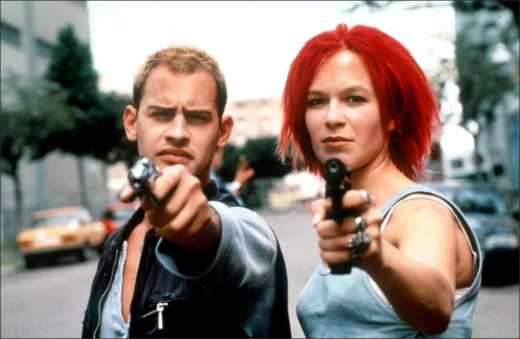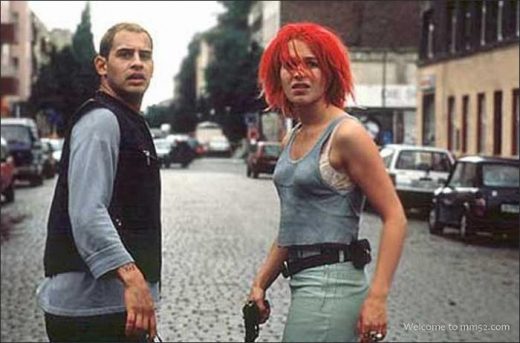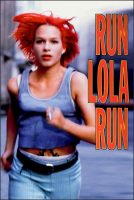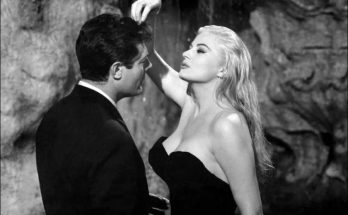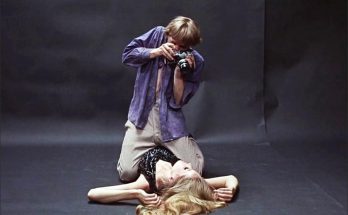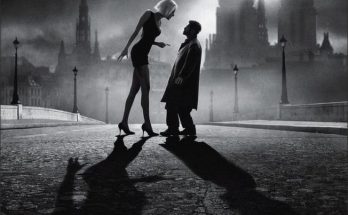Run Lola Run has an interesting mathematics in itself. In order to better understand the subject flow of the movie, it is necessary to follow these three versions carefully. Otherwise, you may get lost in the fast pace of the movie and not be able to control the story flow.
First version
1. Opening (12 minutes): Tykwer lays the foundation of the story.
2. First version (20 minutes): Lola’s effort to find money in Manni.
3rd Call (3 minutes): Pillow chat – 1
4. Second Version (20 minutes): Second version in the run of Lola.
5. Break (3 minutes): Pillow chat – 2
6. Third Edition (20 minutes): Lola’s third run…
During the run, which started from the apartment, from the moment Lola decided to go to her father, the steadicam camera briefly followed her, entered the room of her mother who had a conversation on the phone in the living room and headed for the television in the living room. This shot is the only shot repeated in all three versions. After that, even if Lola runs on the same streets and streets, the angles will be different.
Tykwer shows Lola’s descent from the apartment stairs as animation. It realizes the beginning of each version with such a colorful method and thus brings its movie closer to the computer game. We watch the run of Lola with a quick music for a while. Lola is a highly planned icon, from her red hair, which symbolizes her passion and rebelliousness, to her braced sweatshirt showing her breathing skin, to her tattoo on the navel, and the bra with visible straps.
As a matter of fact, having red hair for young girls in Germany has been a serious fashion for a while, even Berlin Mayor has made a poster imitating Lola in order to explain that she is a young and dynamic president in a campaign. As a result of Tykwer’s objection, the President decided not to use the poster.
There are certain cornerstones in each version of Lola. In his story, there are situations and points that affect his own story as well as those with whom he has changed his life. In the first version, Lola leaves the downstairs neighbor’s grumpy dog without losing time and leaves the apartment. (dot 1) When she goes out on the street, it would be like hitting a woman (person 1) walking with a stroller. The woman turns around and shouts at Lola and swears. Tykwer briefly shows the woman’s life after this point with fast polaroid photos.
As a result of the quarrels following the alcohol problem with her husband, the woman will not be able to prevent the social workers from confiscating her little child and her job will eventually lead to stealing someone else’s baby. During Lola’s run, we go to Lola’s father and her mistress’s workplace dialogues in parallel fiction. Of course, these are video images. It seems that the man is not very happy with this conversation.
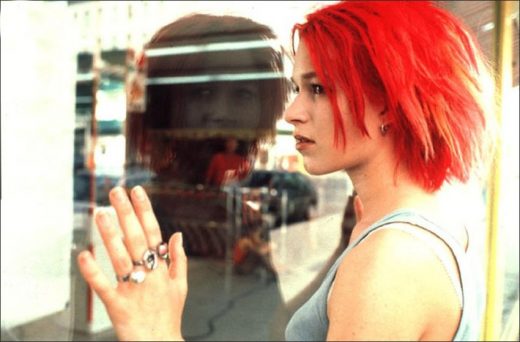
While Lola runs between a group of nuns during the run (point 2), the child with her bike (person 2) proposes to sell her the stolen bike underneath. Lola briefly says “no”. We see the future of the bike child with quick pictures. The owners of the bike catch it and beat it. The boy meets a nurse at the hospital and marries him.
A street where Lola passes is the street where a man named Meyer (person 3) who leaves his car with his car lives. Plans that Meyer appeared on were filmed. Surprised by the passing of Lola, Meyer hits a white car in front of the garage exit. Three robust men come out of the car that Meyer crashed into.
Lola passes by the homeless man who unwittingly finds the money bag in the subway before arriving at his father’s bank. When Lola entered the bank, her father received shock news from her mistress. The woman is pregnant. The man is happy with this news and speaks in a promising way to his mistress.
Guard Schuster, which we saw in the beginning, meets Lola at the bank and takes him inside. Running in the corridor, Lola passes by a woman (person 4). We follow the future of the woman with the same method: The woman will have a traffic accident on the same day, it will be paralyzed from the waist down, and she will not be able to bear it any more and commit suicide.
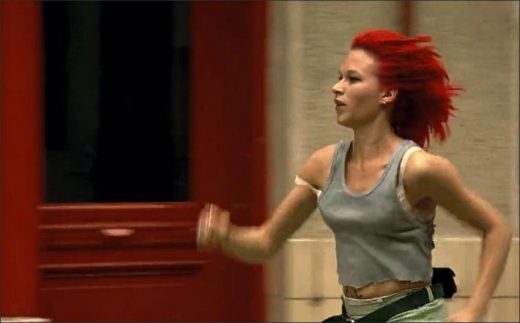
As soon as Lola’s father enters her office, the format goes from ‘video’ to 35. Because Lola has entered the environment. His father is under the influence of the news he has just received and he is excited to start a new life. Lola asks her father for 100,000 Mark. But he cannot concentrate his father’s attention on himself. Lola’s scream causes a few glass items to break and man’s patience is overflowing.
She takes her daughter out of the room as she bought it and on the road, she explains hardly that she will “leave her with her mother and live her own life with her boyfriend”. He even tells Lola that she has no real father. Lola came at the wrong time. (There are wrong times and right times in life. What if Lola came after a sentence that her father’s mistress would soon say?)
He handed Lola to the Guard Schuster, just as he was holding Lola by the arm. Poor Lola rushes to her boyfriend Manni this time. While Lola runs down the street, she gets the attention of an ambulance driver. The driver notices the men carrying a large glass at the last minute and brakes. This stops Lola for a short moment. (point 3).
Manni moves towards the market with the gun in his waist. He enters and starts the heist. At that very moment Lola comes in and has to be involved in the market and robbery. Tykwer shows these moments when Lola can’t reach Manni using a “split screen”. He borrowed a technique that Brian De Palma used frequently in his early days.
Robbery takes place. One of the police officers who came to escape with the money (the song playing in this scene is “What a Difference a Day Makes” from Dinah Washington) accidentally hits Lola in the full chest. We approach Lola’s face, collapsing on the ground. The first version resulted in Lola’s death.
Second version
Lola leaves the apartment for the second time and starts her run. As we did in the first one, when we animated the stairs, there is a deviation in “point 1”. The neighbor who owns the dog trips to Lola. In this way, the speed of Lola falling from the stairs will be cut. It runs slower for a while. This time he quickly hits the woman with a child (person 1). The woman’s future this time is different. After the collision, he goes to play the lotto and wins. It reaches a prosperous life.
As Lola runs among the nuns for the second time, she realizes that one of them is wearing sunglasses. The bicycle boy offers to sell his bicycle again. But Lola’s answer this time is “no, because it’s stolen.” The fate of the child this time will result in an overdose of death in a park.
In this run, Lola passes on the hood of Meyer’s car leaving the garage. (there is a time difference of about three seconds) Meyer is again surprised and hits the same car on the street this time behind him. The three people in the car he crashed out come out again.
In the second version, Lola gets ahead in a way that can be calculated in seconds in some cases in the first version. Sometimes it is late. Indeed, in this version, he collides with the homeless man on the subway and experiences a short waste of time. The response of this loss of time to his father’s dialogue with his mistress is crucial. Because the mistress is pregnant, but she has time to tell the man that she is someone else!
This time Lola dives into the office during a full discussion environment. This time the man is defending his family against his mistress who cheated on him. Lola begins to cry and asks her father for money. Her father slaps him and asks him to go. Lola steals the weapon of the watchman and returns. He takes his father with a gun hostage. It becomes the witness of all office events. Including the woman (person 3) in the corridor we saw in the first version.
This time the woman gets closer to a colleague in the office and goes out for dinner. They will have a sadomasochistic relationship and be happy (!). Lola, who took 100,000 Mark from the bank vault, is running to Manni this time with money. He requests the ambulance driver, who crosses the roads, to leave himself. Distracted, the driver does not see the people carrying glass in front of him this time and he is late to brake.
In this version, Lola has found the money and calls out to her as she enters the market for the full Manni robbery. As the two lovers walk towards each other, the same ambulance that breaks the glass hits Manni. This time we approach the face of Manni, who is dying next to Lola.
Third version
The biggest criticism received by “Run Lola Run” is usually because of this third version. The same story fiction, although there are differences, the fact that it repeats three times in a similar logic may cause the film to be thought of as “a little too hard” after this point. However, Tykwer needs a final won by lovers. And it keeps it to the end.
The third run of Lola starts again on the stairs of the apartment. He ignores the neighbor’s barking dog, leaps over and continues on his path at the same speed. It is faster in its third run. This time the baby won’t hit the woman with the car. When the woman continues on her way, she falls into a street preacher and experiences the stages of becoming a religious woman. This time, Lola, who goes down the street without diving among the nuns, is likely to hit the bike boy. The boy does not have a dialogue with Lola. With the video footage, we see it deviate from the first street. He stops by a buffet and places his order. There he encounters the homeless man who finds the bag of Manni. He sells the bike to him.
In the third version, Lola hits Meyer’s car out of the garage. This time Meyer will not hit the white car on the street. Here we understand that Meyer and Lola know each other. This time Lola does not meet the homeless man she encountered in the first version. Because the homeless man is on a bike now.
Meanwhile, Lola’s father received the news of her pregnancy from her mistress. When the woman tells that the baby is not from her, the person to whom the man will be interviewed receives the news that Meyer is coming. Mistress cannot find time to tell the sad truth to the man. Lola’s father is unaware that her mistress is pregnant with someone else as in the first version. He happily leaves his office and goes to his car to meet Meyer. In this version, Lola cannot catch up with her father.
Meanwhile, Manni notices the homeless man who passes by bicycle in front of the phone booth and starts chasing him. Meyer’s car, which was distracted during this chase, will hit the white car that is coming there. (It means Meyer’s destiny had to hit that white car!)
Lola is still running, but this time she doesn’t know where to get the money. An idea comes to mind as you pass by a casino. He plays number 20 on the roulette table with over 100 marks. As she wins, Lola continues to play at number 20. The scream he uses in this version helps him win one more time at the gambling table. Manni, on the other hand, has reached his bicycle destination. He takes his money back and gives the gun to the homeless man.
In the third meeting of Lola with ambulance, the ambulance stops at the last minute in front of the glass as in the first version. This time Lola gets on the back door of the ambulance, taking advantage of the opportunity. There is a person in the ambulance who is dying of a heart attack. This person is none other than bank guard Schuster. Lola takes her hand and makes her heal. (One of the situations that caused conservative audiences to compare Jesus to Lola).
As soon as she hit 12 o’clock, Lola arrived at the phone booth. While searching for Manni, he sees him getting off a black car in the future. He handed over the money to his bosses and took a well done Manni. He walks over to Lola. Manni approaches her lover happily, unaware of Lola’s experiences. Even “did you run up to here?” he asks. Lola actually lived the same events for him three times (!). They hold hands and Manni informally asks that question: “What’s in the bag you have?”
A movie that pressed ‘back’ button
“Run Lola Run” is one of the rare films that includes different movie formats, camera angles, fiction effects and even three different versions of the same story. The movie directs us not only to how easy it can be played over time, but also to reflect on the sacrifice of true love.
In addition, “Run Lola Run” has been a movie for director Tom Tykwer, which has led to a long-standing relationship with the young actress Franka Potente, who has not only brought a reputation in world cinema but also brought a lot of life to Lola.
Tykwer’s synopsis consisted of three pages and the synopsis sent to the team had sentences like this: “The story begins again here,” “It ends here again”. So after reading these three pages, people went to the young director and asked what kind of movie it was. Tykwer’s response was: “This is an experimental movie for a wide audience.” Still, Tykwer managed to somehow cover this expensive budget. In return, the movie was even released in American cinemas. The movie, which was screened in US theaters under the name “Run Lola Run”, broke the record that Wolfgang Petersen’s “Das Boot” (1981) broke 20 years ago and became the most watched German film in the USA. Franka Potente, who has a throne with Lola, continues to play in German and Hollywood films.
Run Lola Run (1998)
Directed by: Tom Tykwer
Starring: Franka Potente, Moritz Bleibtreu, Herbert Knaup, Nina Petri, Joachim Król, Armin Rohde, Heino Ferch, Suzanne von Borsody, Sebastian Schipper, Julia Lindig
Screenplay by: Tom Tykwer
Production Design by: Alexander Manasse
Cinematography by: Frank Griebe
Film Editing by: Mathilde Bonnefoy
Costume Design by: Monika Jacobs
Set Decoration by: Irene Otterpohl
Art Direction by: Attila Saygel
Music by: Reinhold Heil, Johnny Klimek, Tom Tykwer
MPAA Rating: R for some violence and language.
Distributed by: Prokino Filmverleih
Release Date: August 20, 1998
Visits: 370
